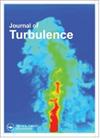旋转湍流特刊
IF 1.5
4区 工程技术
Q3 MECHANICS
引用次数: 0
摘要
在过去的几十年里,由于旋转湍流的基本利益和与各种自然和工程过程的相关性,它吸引了广泛的研究努力。本期关于旋转湍流的特刊收集了来自知名研究人员的五篇文章,以展示这个令人兴奋的领域的各种物理现象和最新进展。本特刊由L. Biferale的一篇综述论文开篇,他对不同复杂程度的旋转湍流进行了深刻的讨论,并对特刊上的论文进行了很好的介绍。并对该领域的发展前景进行了展望。G. Boffetta及其同事的论文报告了一项使用实验室实验和数值模拟的研究,该研究限制在可变高度域中的自由衰减旋转湍流。作者认为,垂直约束对大尺度柱状涡的形成有重要影响,特别是延缓了气旋-反气旋不对称的发展。这种效应在边界条件有结构差异的实验和数值模拟中都观察到了,证明了他们的发现的稳健性。夏忠、陈思和同事的论文对沿展向旋转平面Couette流的滞回特性进行了数值研究。通过进行两组直接数值模拟,其中Ro沿两个相反方向的步长变化,他们证明了在考虑的最高雷诺数的大规模实现中存在滞后行为,这也体现在湍流统计中。R. P. J. Kunnen的论文概述了我们目前对湍流旋转瑞利-巴萨姆德对流地转体制的认识。详细描述了旋转对流地转状态的相图,并讨论了以不同流动结构和传热尺度为特征的子范围。讨论了地转对流实验研究中的复杂问题,如区域大小、离心浮力的影响、约束和壁面模式、非奥伯贝克-布西内斯克效应和惯性波共振。S. Horn和J. M. Aurnou基于科里奥利-离心对流系统,计算研究了离心浮力对类龙卷风涡形成的影响。他们表明,离心浮力与自然发生的龙卷风有关,在科里奥利-离心对流的准旋转状态下产生了丰富多样的龙卷风形态。编辑委员会感谢作者为本期特刊所作的贡献,并希望本期特刊将促进该领域的进一步发展和兴趣。本文章由计算机程序翻译,如有差异,请以英文原文为准。
Special issue on rotating turbulence
Rotating Turbulence has attracted extensive research efforts over the last decades due to its fundamental interests and relevance to a variety of natural and engineering processes. The present special issue on Rotating Turbulence collects five contributions from renowned researchers to showcase the variety of physical phenomena and recent advances in this exciting area. This Special Issue is opened by a review paper by L. Biferale, who presents an insightful discussion of Rotating Turbulence with varying degrees of complexity and provides a great introduction to the papers on the special issue. Besides, the paper gives thought-provoking future prospects in this area. The paper of G. Boffetta and coworkers reports a study of freely decaying rotating turbulent flows confined in domains with variable heights using laboratory experiments and numerical simulations. The authors show that vertical confinement has important effects on the formation of large-scale columnar vortices and in particular delays the development of the cyclone–anticyclone asymmetry. This effect is observed both in experiments and in numerical simulations which have structural differences in the boundary conditions, demonstrating the robustness of their findings. The paper by Z. Xia, S. Chen and coworker presents a numerical investigation of the hysteresis behaviour in a spanwise rotating plane Couette flow. By performing two groups of direct numerical simulations where Ro varies in steps along two opposite directions, they demonstrate the existence of hysteresis behaviour in the large-scale realisations at the highest Reynolds number considered, which is also manifested in the turbulent statistics. The paper of R. P. J. Kunnen presents an overview of our current knowledge of the geostrophic regime of turbulent rotating Rayleigh–Bénard convection. The phase diagram of the geostrophic regime of rotating convection is described in detail, with a discussion of the subranges characterised by different flow structures and heat transfer scaling. Complications in the laboratory studies of geostrophic convection are discussed, such as domain size, effects of centrifugal buoyancy, confinement and wall modes, non-Oberbeck–Boussinesq effects and inertial wave resonance. In the paper by S. Horn and J. M. Aurnou, the effects of centrifugal buoyancy on the formation of tornado-like vortices are studied computationally based on the Coriolis-centrifugal convection system. They show that centrifugal buoyancy is relevant for naturally occurring tornadoes and a rich variety of tornado morphologies are produced in the quasi-cyclostrophic regime of Coriolis-centrifugal convection. The Editorial Board thanks the authors for their contributions to the special issue and hopes that this special issue will stimulate further progress and interest in the area.
求助全文
通过发布文献求助,成功后即可免费获取论文全文。
去求助
来源期刊

Journal of Turbulence
物理-力学
CiteScore
3.90
自引率
5.30%
发文量
23
审稿时长
6-12 weeks
期刊介绍:
Turbulence is a physical phenomenon occurring in most fluid flows, and is a major research topic at the cutting edge of science and technology. Journal of Turbulence ( JoT) is a digital forum for disseminating new theoretical, numerical and experimental knowledge aimed at understanding, predicting and controlling fluid turbulence.
JoT provides a common venue for communicating advances of fundamental and applied character across the many disciplines in which turbulence plays a vital role. Examples include turbulence arising in engineering fluid dynamics (aerodynamics and hydrodynamics, particulate and multi-phase flows, acoustics, hydraulics, combustion, aeroelasticity, transitional flows, turbo-machinery, heat transfer), geophysical fluid dynamics (environmental flows, oceanography, meteorology), in physics (magnetohydrodynamics and fusion, astrophysics, cryogenic and quantum fluids), and mathematics (turbulence from PDE’s, model systems). The multimedia capabilities offered by this electronic journal (including free colour images and video movies), provide a unique opportunity for disseminating turbulence research in visually impressive ways.
 求助内容:
求助内容: 应助结果提醒方式:
应助结果提醒方式:


